Varietal features of the Medoc apple tree
One of the most popular horticultural crops is the Medoc columnar apple tree. It is unpretentious in care, grows quickly and gives a stable, tasty, healthy harvest. The species was bred in 1987. The variety was obtained by crossing two popular crops. As a result, the hybrid began to grow throughout Russia.
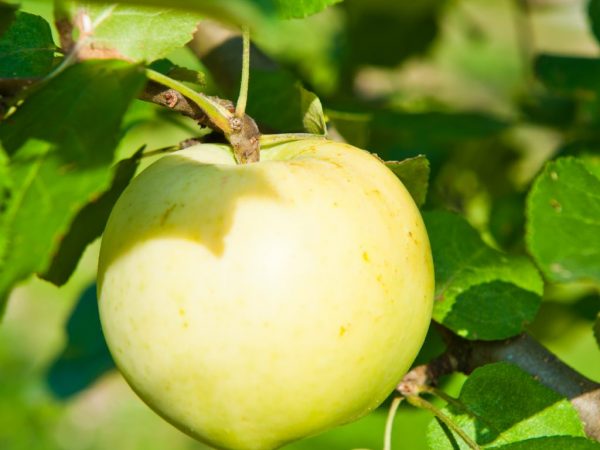
Varietal features of the Medoc apple tree
Variety characteristic
The apple tree requires minimal maintenance and rarely gets sick. Even during an epidemic in the garden, the tree retains its yield indicators.
Medoc belongs to the early varieties. The columnar apple tree has the shape of a half-dwarf and is suitable for decorating any garden. The growth force of the crown is so powerful that from the first years the Medoc will begin to stand out against the background of other trees.
General characteristics of the variety:
- high early maturity;
- immediately after planting, in the first year, you can expect the first fruits from the culture;
- the maximum yield is set for the 5th year: the growth does not stop, but the number of fruits remains the same;
- after the first years of active growth, the lateral branches of the tree begin to stretch;
- the average yield of an adult apple tree is from 5 to 9 kg - care, to which the gardener should pay more attention, helps to double it.
The variety is distinguished by its high frost resistance. Like most domestic species, Medoc withstands long cold winters well. Freezing of a tree is rare, and immediately after the arrival of heat, the culture quickly recovers. The middle zone of Russia is an ideal place for seedling germination.
The drought resistance of the tree is average: if the summer is too hot, the trunk is well moistened.
The favorable neighborhood allows the Medoc variety to give not only a stable, but also a good harvest. Cross-pollination improves the quality characteristics of apples. The best "neighbor" for the species will be Antonovka or another culture with similar characteristics. In such conditions, the fruits have time to ripen quickly and gain sweets.
Advantages and disadvantages
The species fructifies quickly, so by the beginning of autumn the gardener can harvest. The compactness of the tree is another advantage of the variety - the semi-dwarf does not require a lot of free space and is suitable for growing on small plots.
The species is distinguished by good resistance to common diseases. Powdery mildew or fungus are not afraid of a semi-dwarf. Preventive work improves the protective mechanisms of the tree. Spraying with fungicides is used.
Medoc rarely suffers from pests - if the gardener puts out the nets in a timely manner, this will protect the culture. The main advantage of the variety is its increased winter hardiness. A tree is planted even in the north of the country.
There are few disadvantages of the Medoc apple tree. Planting material will cost the gardener more than other popular varieties.
The half-dwarf fruiting period is short, and it is unprofitable to grow apples for sale. The compactness of the tree is also a significant drawback - weeds constantly grow around the trunk, and they have to be removed twice as often.
Description of the fetus
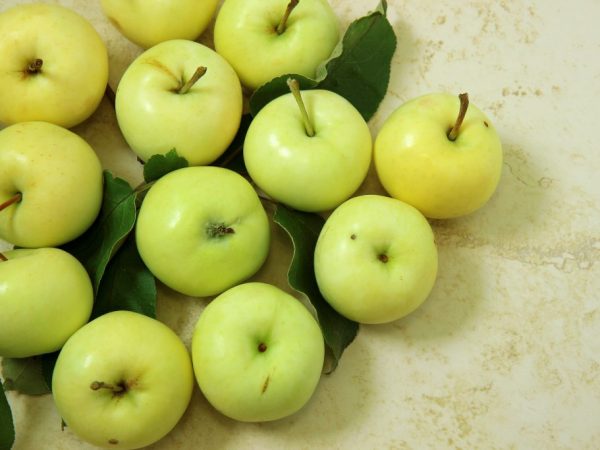
Apples have good taste.
The apple tree gives a stable harvest - the fruits are medium and large. The size of the apples directly depends on the general care during the fruiting period. Medoc is distinguished by fruits, the weight of which does not exceed 300 g. The older the tree, the larger the apple - the columnar culture improves its characteristics over the years.
According to the description of the Medoc apple tree, the fruits have the following characteristics:
- round shape;
- apples have a dense skin;
- the color of the fruit is green, and as it ripens, a characteristic red blush appears on them;
- if the apples are in the shade, then they turn yellow closer to the moment of ripening;
- the flesh is white - it has a delicate structure;
- apples are juicy, but with a weak aroma;
- the pulp has a coarse-grained structure.
The variety has excellent taste - from which the name of the species comes from. The pulp is sweet, and the longer the apples lie, the more "honey" they get. The use of fruits is universal: fruits are used to prepare delicious dishes or are eaten raw.
Description of the tree
The columnar apple tree belongs to natural dwarfs. The trees are medium-sized, but do not grow on the sides. The average height of the culture is up to 2-2.5 m. The dimensions of the crown are small. According to the description of the tree, the crown width does not exceed 30 cm.
The apple tree has a massive, well-developed root system. Thanks to this structure, the culture tolerates transplanting well, if there is an urgent need for it.
The tree is upright. Foliage grows abundantly around the trunk. The annual growth rate is moderate. Every year the apple tree grows by 10-15 cm. If the top dies, the tree is restored for a long period. To create a columnar shape, no more than one kidney is left at the apex.
The frequency of fruiting
Under favorable conditions, the apple tree begins to bear fruit for 1-2 years after planting. It all depends on the growing system and weather conditions. Immediately after the first fruiting, it becomes regular. Even a cold snap or sudden changes in temperature cannot affect this factor.
Only the fallen inflorescences can change the quantitative indicator of the yield. The high fruiting rate is due to the alternating areas where apples are formed.
Landing
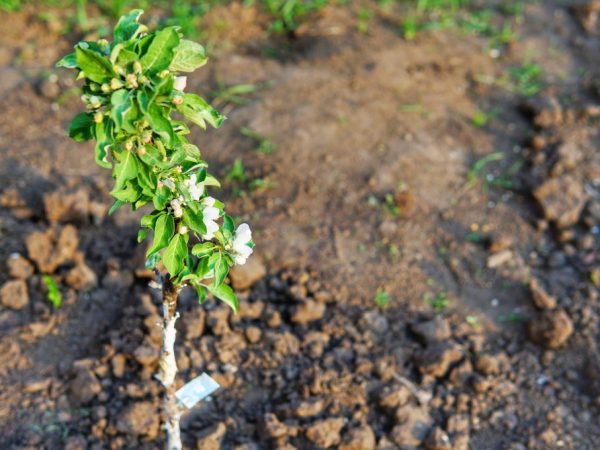
Only healthy seedlings are suitable for planting.
The variety is planted in a simple manner, like any other apple tree. Planting is carried out at a certain period and with soil fertilization. The correct planting material is chosen for these purposes. It should be two years old so that it quickly adapts to new conditions.
Such a seedling already has shoots, but leaves have not yet formed. It is important to check the condition of the material before purchasing. There should be no specks or traces of a previous illness on it.
If the material is properly grafted, it should have a strong root system. To check its condition, the gardener pulls off one root - if it comes off quickly, you cannot take such a seedling. Under the bark, which is still thin, a green trunk should be visible.
Annual crops need to be pre-processed and stored only until spring planting.
Disembarkation dates
Pome crops are planted twice a year. Weak or sensitive seedlings are planted in early spring. During the same period, you can plant annual crops. The spring procedure differs in that by the fall and the arrival of the first frosts, the young planting material will take root - it will be strong and protected.
The variety is planted in early spring, but no later than the moment the first buds appear on other trees. At the same time, the gardener makes sure that the topsoil is warmed up.For this reason, seedlings are not grafted immediately after winter.
Planting in the fall is easier, but further care of the seedling takes longer. The first step is to harvest the entire crop. Only after that, a young tree is planted. It is necessary to guess over time - at least a month should remain before the expected first frost.
In this case, the tree will have time to germinate and strengthen its root system. After the autumn planting, measures are taken to warm the seedling for the winter.
Seat selection
The columnar apple variety Medoc is not demanding in care, but the rules for choosing a land plot are followed for it. Like many other trees, the half dwarf loves sunlight. You need to choose a site on the south side.
If there are shelters that are also needed for the culture during the cold snap, then they should not create a strong shade.
Landing is not carried out in the lowlands. In this case, the tree rhizome will constantly suffer from excess moisture. The opposite effect will turn out - instead of receiving nutrition, the rhizome will rot, and the trunk will dry out.
Choose the right neighborhood. If tall trees grow nearby, they will shade Medoc. As a result, the entire crop will be deformed. Not only will its appearance deteriorate, but also its quality characteristics will deteriorate.
Disembarkation scheme
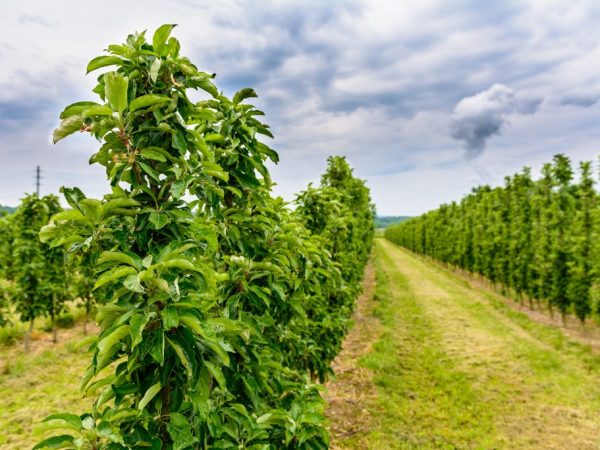
Trees are planted in rows
Before disembarking, a landing pit and a land plot are prepared. The soil must be cleared of any roots of other plants. You need to dig up the top layer to land faster. A pit is created two weeks before it. The planting process includes:
- creation and fertilization of the planting pit. After the hole is ready, fertilizer is poured into it. The nutrient mixture will help the young rootstock grow faster. They put humus or slurry in a pit - they use a large amount of organic matter. The first week, the top dressing is settled, and after 7 days it is dug up with the top layer of soil. In the second week, the pit is tamped. After 14 days, drainage is placed on the bottom of the well. It is needed only in the case of high groundwater - above 2.5 m. After that, a stake is installed, which will serve as a support for the seedling;
- planting a young tree. The roots are neatly leveled and placed in the pit. Sprinkle fresh soil on top. Gently tamp. Water the tree with 5-6 buckets of water. The barrel is fixed with a support. The next week, the culture adapts to new conditions.
Before planting, if the soil is too clayey, river sand is added. The optimal size of the hole is a depth of at least 70 cm and a diameter of no more than 1 m. It is impossible to make the hole too large, because the seedling will put all its strength into the growth of the rhizome.
Correct distance
The Medoc apple tree rarely dries up in cramped conditions, because it does not require free space. A tree takes root near the paths or at the aisle to the garden. Landing is carried out in rows. The optimal distance between them is 1 m.
There should be a distance of at least 60-70 cm between the seedlings. The trees tied to the support do not grow on the sides and start growing rapidly upward. The denser the planting, the worse the culture is saturated - as a result, its yield decreases.
Care
Proper care includes watering, loosening the topsoil, fertilizing and the obligatory pruning of branches. Additionally, weeding of the land is carried out. If this is not done, the roots will draw moisture out of the apple tree rhizome.
Prevention is carried out twice - immediately after the restoration of the tree after winter and after fruiting. During these periods, the culture is vulnerable.
Loosening the soil is important. It is combined with watering and fertilizing. Loosening increases the degree of impregnation of the rhizome. After planting, constant care is established: the tree is allowed to settle for no more than a week.
Irrigation works
Variety care includes watering - this is a prerequisite for rapid growth of the tree.Without moistening the soil, the apple tree loses its inflorescences, and the fruits do not gain their characteristic sweetness. To prevent this from happening, watering is installed with the following scheme:
- in spring and autumn, the tree is watered 3-4 times;
- in the summer, if a drought begins, they carry out abundant moisture, but also 4 times;
- in winter, irrigation work is stopped and resumed in spring, after the ground has warmed up.
For this, the settled liquid is used. Better to choose rainwater or tap water. If river water is used, it can cause diseases - the gardener will not know the exact content of pathogenic microflora.
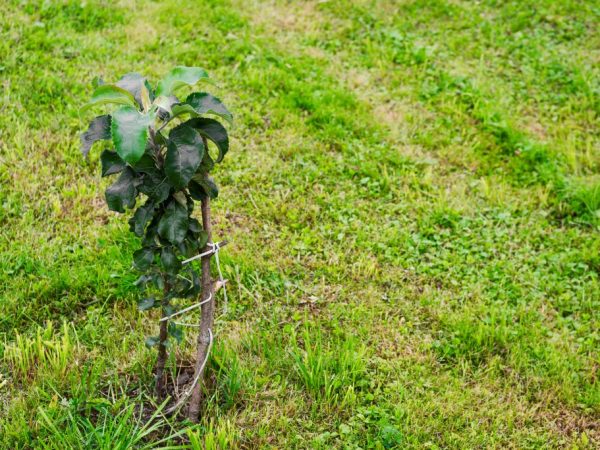
The tree is watered with warm water
Previously, the water for irrigation is heated, and the container is left outside in the summer. They bring liquid to the Medoc apple tree under the trunk: the soil layer should not be eroded, therefore, the younger the culture, the farther from its trunk watering is carried out.
They irrigate the apple tree after sunset. Spraying can be carried out immediately afterwards. During the fruiting period, Medok is watered until the apples begin to ripen - during this period, the amount of moisture introduced must be reduced.
Top dressing
Fertilization is an important part of apple care. Two types of feeding are used - organic and mineral components. Feedings are alternating: you cannot apply them at the same time or do not take a break between fertilization.
An excess of nutrients leads to the opposite effect - the root system begins to rot, and the branches begin to dry. To prevent diseases in the variety, top dressing is also added. Nutrition is especially important during the flowering period and during the active growth of the seedling.
It is better to apply top dressing in this way:
- 3-4 times a year organic matter is used - this is manure, compost or bird droppings;
- during the period of growth of the trunk and development of branches, nitrogen fertilizers are applied;
- during the formation of fruits, mixtures with phosphorus and potassium are useful.
Combined top dressing will not only strengthen the tree, but also protect it from harmful environmental factors. Before fertilization, the top layer of the soil is cleared of weeds and the soil is loosened. Before using manure or poultry manure, it is diluted with water to reduce the concentration of active substances.
When the fruits begin to ripen and change color, feeding is stopped. The tree does not need nutrients for the winter. All it takes to protect a crop is mulch. They use straw, as well as special shelters. High winter hardiness in combination with such activities will allow the apple tree to hold out until spring.
Crown pruning
Crop care is not complete without pruning. A semi-dwarf is a small tree. He has a lot of ringlets, on which ovaries are formed, and then fruits. The growth of side shoots is average, so the Medoc is cut off no more than once a year. Standard varieties need double pruning - in spring and autumn.

Tree needs pruning once a year
The timing of pruning depends on these factors:
- the gardener assesses the condition of the tree - if it has a lot of damage or an irregular crown, then pruning is carried out urgently;
- perform spring pruning before bud formation, and autumn pruning not earlier than the entire crop is harvested;
- before winter, such an event allows you to warm the culture and prevent the reproduction of parasites or pests;
- pruning in spring minimizes the cost of feeding the tree unnecessary, unproductive branches.
Half-dwarf pruning is carried out no more than once every two years. It is better to remove side shoots as soon as they appear. If they become woody, the Medoc apple tree will begin to lose moisture after pruning.
During the formation of the crown, it is impossible to damage the top of the tree - its bud. In this case, it will be necessary to form a "substitute" from the young shoot, which will become a new trunk, otherwise the culture will die.
Ripening and fruiting
The ripening period falls at the end of August or the beginning of September.If you plant a seedling in the spring, by the fall it is able to bloom and give the first harvest. But for a gardener, such a fast flowering is not a good sign - it is better to immediately remove the ovaries and let the tree grow stronger until next season.
In this case, the root system will have time to develop and by next spring full-fledged ovaries will appear, and from them - beautiful apples.
Stable fruiting begins from the fifth year. Apples appear on the trunk - the tree does not have long branches like other varieties. The fruiting areas change every year. The average lifespan of a culture is 15-17 years.
Harvesting and storage
Market maturity does not come earlier than August. In September, the harvested apples can be used to make delicious juices or jams.
The shelf life of the fruits is short, but the apples are well transported. If you put the fruits in a cold dark room, they can lie for up to one and a half months and will not deteriorate. Immediately after harvesting the apples are "laid down" - in 1-2 weeks they are "sugar".
Gardeners reviews
Gardeners' reviews about the Medoc apple variety are ambiguous. The main advantage of the hybrid is delicious fruit and ease of maintenance. At the same time, the tree of the variety is small, and the storage of fruits is limited in time.
The variety is popular only among gardeners who have a small plot of land. In this case, the disadvantages of culture are completely leveled.

